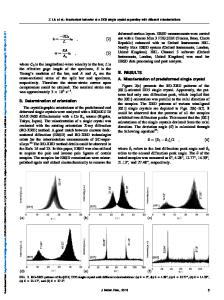Investigation on In Situ Tensile Behavior of Superalloy Bicrystals with Different GB Misorientations
- PDF / 1,939,673 Bytes
- 6 Pages / 593.972 x 792 pts Page_size
- 47 Downloads / 343 Views
TRODUCTION
AS fundamental materials for turbine blades, nickelbase single-crystal (SC) superalloys tend to produce much low-angle boundary (LAB) in casting process. Some levels of LAB may be accepted without significant loss in mechanical properties. Ross et al.[1] indicated that the rupture strength would not be reduced if the misorientation of GB was 6 deg or less. For PWA1483 alloy, when GB misorientation exceeded 10 deg, a rapid drop in creep capability occurred.[2] However, in modified PWA1483 alloy with the deliberate addition of Hf and B, there was no significant fall in creep strength even when the GB misorientation was as high as 25 deg. It was determined that GB misorientation limit may be different for the superalloys with distinct compositions.[3,4] Most of mechanisms about GB effects were derived from face-centered cubic (fcc) metals. It is well known that grain boundary (GB) has a strengthening effect on metallic materials by impeding dislocation motion.[5–7] With steady accumulation of piled-up dislocations near GBs, microcracks begin to nucleate. For polycrystalline materials, there are various GB shapes closely related to stress concentration and crack nucleation. The effect of GBs depends upon their individual characteristics.[8] Firstly, the H. XU, Ph.D. Student, P. LI, Associate Professor, and Z.F. ZHANG, Professor, are with the Shenyang National Laboratory for Materials Science, Institute of Metal Research, Chinese Academy of Sciences, 72 Wenhua Road, 110016 Shenyang, P.R. China. Contact e-mail: [email protected] Y.Z. ZHOU, J.G. LI, T. JIN, and X.F. SUN, Professors, are with the Superalloy Division, Institute of Metal Research, Chinese Academy of Sciences, 72 Wenhua Road, 110016 Shenyang, P.R. China. Contact e-mail: [email protected] Manuscript submitted November 20, 2013. Article published online April 25, 2014 3876—VOLUME 45A, AUGUST 2014
angle between slip plane and GB plane will affect the dislocation movement and further dominate the interaction between slip bands (SBs) and GBs.[9] For example, in Al bicrystal, Zaefferer et al.[10] found that the GB misorientation of 8.7 deg did not show any orientation change, which was interpreted in terms of free dislocation penetration. In contrast, 15.4 deg and 31.5 deg bicrystals showed certain orientation changes which were attributed to the pilling up of dislocations. Secondly, after systematically investigating the effect of GB misorientation on the fatigue behavior of Cu bicrystals, Zhang et al.[11–13] found that large-angle GBs always become the preferential sites to initiate fatigue cracks, independent of the angle between GB plane and the stress axis. For the columnar crystals containing low-angle GBs, SBs can pass through low-angle GBs continuously and fatigue cracks nucleate along PSBs rather than GBs. However, for Cu bicrystal with a perpendicular GB, the cracks always occur in the interior of the grain with soft orientation. Recently, using in situ tension tests by scanning electron microscopy (SEM), Guo et al.,[14] reported that SBs could not pass throu
Data Loading...











